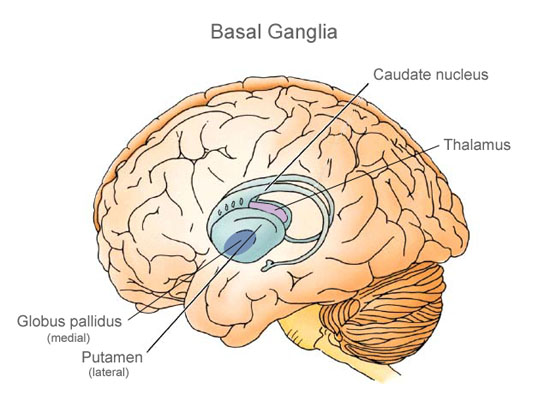Huntington’s chorea
Chorea, the Greek word for “dance,” is used to describe the involuntary movements of the body especially of arms, legs and face. In Huntington’s chorea, these movements tend to be spastic and ballistic, and they dramatically affect normal functioning.
Huntington’s chorea is a dominantly inherited disease which is passed down through families by an autosomal dominant form of inheritance. It was first described by George Huntington in 1872. Incidence is 5-10/100,000.
The disease often presents as “nervousness“, and depression. Eventually progresses to include dementia and slowed eye movements. In juvenile HD, rigidity and parkinsonian tremor may be the primary manifestation. Generally, symptoms are first observed when the victim is in the ’20s or ’30s, and the degeneration slowly progresses, ending in the victim’s death some 10 to 20 years later.
The disease progresses with increasing chorea and loss of mental abilities. Eventually, abnormal movements and dementia become so severe that the person can no longer care for his or her self. 
Huntington’s chorea is due to slow degeneration in the basal ganglia, which eventually leads to cell death in the brain and the decrease and increase of various neurotransmitters. The symptoms of the disease are caused by a significant reduction (volume and activity) of two principal neurotransmitters (naturally occurring chemicals in the brain) – namely Acetylcholine and GABA, in turn affecting the activity of the neurotransmitter Dopamine, which becomes hyperactive. The disorder is partly characterized by an increase in the availability of dopamine, which can cause symptoms of chorea. HD is a basal ganglia disease; the portions most severely affected are caudate and putamen.
Huntingtons can be diagnosed on MRI by caudate atrophy with appropriate history, and also by genetic testing.
At present, there is no cure. The aim is to treat symptoms and support and protect the patient. Drugs can control the chorea somewhat, but benefits are often outweighed by the side effects. Caretakers must see to the person’s basic needs.
These include
- hygiene
- skin care
- bowel and bladder care
- feeding.
One must stay alert for suicide attempts. The person’s family often needs emotional support. Caring for the person at home is often beyond the family’s capacity.
